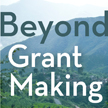Helping Funders Drive Impact Beyond Grant Making
Social change innovators are using more of their resources to do more good than ever—often by going beyond grant making with the help of fiscal sponsors and other intermediaries.
 As my colleagues have noted before on this blog, philanthropy is currently undergoing a sea change: Increasingly, social entrepreneurs, change agents, and impact-minded donors are using a wider variety of tools to pursue the social good they seek. They are going beyond grant making to amplify their impact.
As my colleagues have noted before on this blog, philanthropy is currently undergoing a sea change: Increasingly, social entrepreneurs, change agents, and impact-minded donors are using a wider variety of tools to pursue the social good they seek. They are going beyond grant making to amplify their impact.
This change brings exciting new opportunities, but it also brings new challenges. Among them: the need for foundations and other funders to operate effectively in areas that may be outside their core competencies. Recently, three of my Arabella colleagues—Gwen Walden, Lauren Marra, and Katrina Briddell—explored this challenge in an article for the spring 2015 edition of the Foundation Review.
The article, available in full here, uses a series of case studies (based on the authors’ work at Arabella) to explore how funders can use third parties’ specialized skills and experience to extend their own capacities to do things such as develop effective impact investing programs, incubate new projects and organizations, facilitate collaborations that cross institutional and even sector boundaries, advocate for change, and more.
A few of the article’s main takeaways:
1. By going beyond grant making, funders can significantly amplify their impact—and consultants and other intermediaries can help them do it. The authors note that “funders can effect transformational change at the systems level” through endeavors that go beyond grant making, but they also note that “taking on these endeavors is neither easy nor low risk.” Consultants and other intermediaries can help by providing issue expertise, technical acumen, and networking support, as well as additional capacity, external perspective, and skill implementing complex programs and unfamiliar vehicles: “By bringing their own core competencies and skills into the mix, [such experts] can augment the toolkit of approaches at funders’ disposal, enabling efficiencies and better allocation of time and resources.” And that can translate into more impact, both for particular funders and for the field of philanthropy.
2. Experts can be particularly helpful for funders using innovative vehicles that enable more effective collective action. Working with savvy fiscal sponsors and experts in collaboration, innovative funders with overlapping but not-quite-identical missions are pooling their resources and generating shared impact—often more effectively than they could by going it alone. One of the keys to their success is working through intermediary organizations that have both the technical expertise to efficiently manage operational demands and the facilitation skills to build alignment with programmatic questions. Such organizations are enabling funders to work together quickly and efficiently to respond to emergent needs in our rapidly changing world.
3. Even when they’re relying on experts for support, funders still have key roles to play—notably in decision making and relationship management. While funders can effectively use consultants to augment strategic planning and help build understanding and buy-in for programs that go beyond grant making, the authors’ experience shows that “decision makers in the foundation should be the arbiters of all major strategy or policy moves.” Funders also need to maintain crucial relationships with stakeholders such as grantees, fellow funders, and partners from other sectors, and take the lead on important communications. For initiatives that extend beyond grant making to succeed, funders should plan to invest the necessary time to maintain these relationships, while bearing in mind that all partners may be on comparatively unfamiliar ground.
4. In the end, the movement beyond grant making means funders have an increasing number of tools they can use to drive impact—as well as more opportunities to use multiple tools at the same time. “Sometimes,” the authors note, “the right solution is for donors to collaborate to conduct advocacy, which eventually leads to the need to incubate a new organization—which might wind up taking grants, making grants, deploying impact investments, or all of the above.” Efforts that go beyond grant making can and often should go hand in hand with grant making programs. The point is to find the right mix of approaches to produce the outcome you seek.
The article’s case studies trace a variety of ways in which we at Arabella have seen such work lead to significant impact, and they help make clear why we are proud to support such efforts. To learn more, download the complete article.
*
Steve Sampson is Arabella’s editor-in-chief and head communicator. He engages on a wide range of client projects and helps develop publications spanning the full range of philanthropic endeavor.
